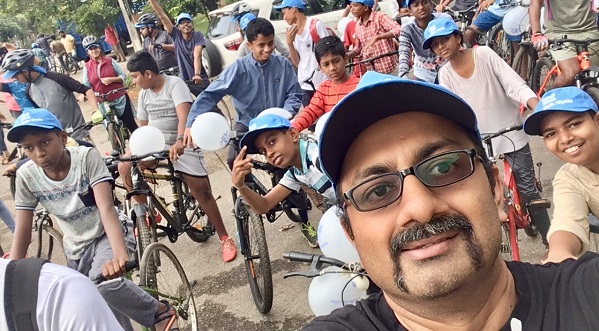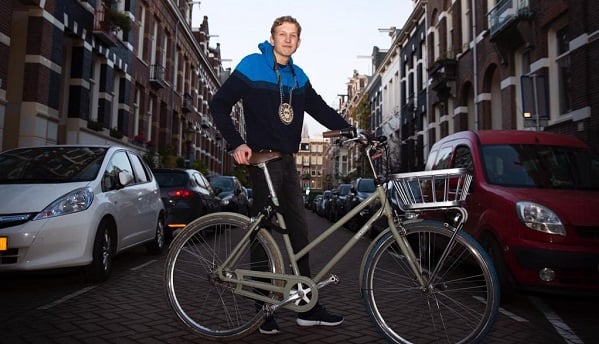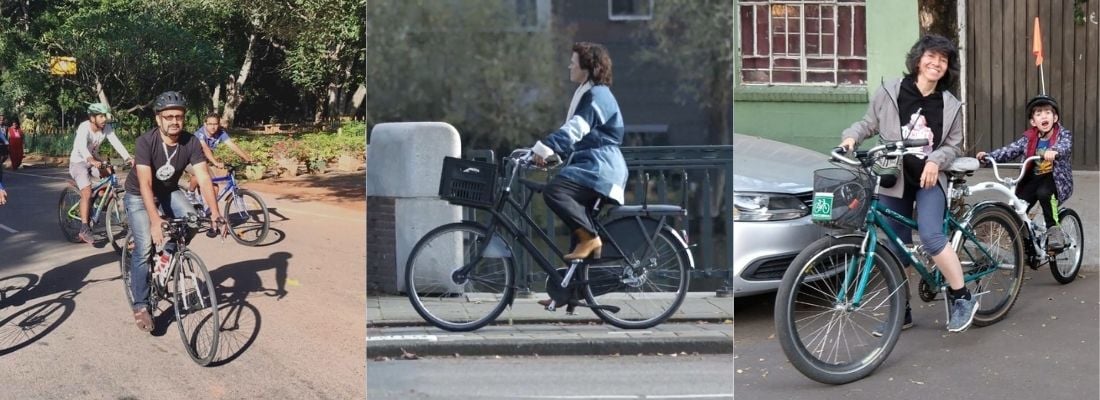Cycling around the globe: Bicycle Mayors Amsterdam, Bangalore and Mexico City
People around the world choose the bicycle more often since the outbreak of COVID-19. We started to cycle more around the globe. Did you know, the world counts 130 Bicycle Mayors? They are part of the international network Bycs. In this first edition of this series we take a look at Bengaluru, Amsterdam and Mexico City, with different challenges asking for different solutions.
Sathya Sankaran has been a voluntary Bicycle Mayor of Bengaluru, India, a city that has 12 million inhabitants and 8 million motor vehicles. Congestion and emissions is a big problem. Aside from this voluntary job, as a consultant Sathya helps to develop sustainable urban space. We help set up projects to reduce carbon emissions.
Bengaluru has been growing too fast and is One of the fastest growing cities in India and across the world. More and more people are coming to the city because it offers employment. Bengaluru has developed as a tech city, but we are still stuck with an infrastructure system that is very old. Our roads are built for a different era. Of the 8 million motor vehicles, we count 6,5 million two wheelers, motorbikes.
The last 15 years cycling was picking up, but not strong. Climate in Bengaluru is very good for a tropical country: from 10 degrees in winter time to 40 degrees in summer. In Bengaluru we mostly make use of the car or the motorbike. There is not much in between. And this brings me to the next challenge; getting people to see the benefit of the bicycle. They don’t see how riding a bicycle should be favoured over riding a motorbike. It is not like you have a car that has four wheels, a rickshaw that has three and then a bicycle that has two, the motorbike has two wheels and is faster. The sense is that the bicycle does not change the congestion problem? So I needed to find another motivation.
From earlier experience I needed to engage the three pillars of democracy: government, society and the industry. 40% of our emissions comes from commute. And we are very tech heavy. That was our ‘industrial revolution’. In 2018 I launched a platform called ‘Cycle to Work’. This platform gamified the social experience through the use of a bicycle. It was about which company has the largest number of cyclists. But the employers said they could not instruct people to cycle. It is too dangerous and if something happens they will be held responsible. So we created a leaderboard on which I showed the participating companies and the number of kilometres the employees were traveling by bike. Every company was appointed a bicycle ambassador.

Photo: Bicycle Mayor Bangalore Sathya Sankaran
I needed people to set an example for everyone else. And that started with the companies. The image used to be that earning a lot of money means buying a car and so that image also needed to change. Set an example by making a statement that you don’t need a car. And this obviously takes time.
People want to be seen as a hero. Every day they go to the platform to see if their company is on top. Every quarter a company gets an award. The people in this city are very tech minded, so this works! Today we count 700,000 kilometres by bicycle, or 83,000 trips by 2,000 people and 157 tons of carbon dioxide emissions saved. Doing this, I tapped into people’s need, fitting to the culture of Bengaluru.
Government wants to see more bicycles before they change the infrastructure. Cycle lobby is not very big. Car lobby is still a lot bigger. But the number of accidents are high, due to bad driving skills and safety in general. We need to improve this. Death rates are high in India. So that is part of my next challenge. We are not tracking cycling accidents. India is hesitant about going back to a bicycle. They prefer either a motorbike or a car. The comprehensive mobility plan for the city had planned for 174 km cycling tracks in 15 years’ time. Which I thought was ridiculous. We need 200 km every year! We went bargaining like buying vegetables and ended at 600 km in 15 years. Now I go around tweeting #mission600 to put pressure on this plan.
The cost of a bicycle is similar to a phone. You buy so many phones, why not a bicycle instead? Now around 2 million people in our city own a bicycle. Bicycle rides have gone up five times in Bengaluru since the lockdowns compared to 2019. #VisionOneCrore means 10 million people owning a bicycle. This is the big target.
Cycling SUPER heroes in Amsterdam
Amsterdam is known as the bicycle heaven, but it has its own challenges. Amsterdam has 800,000 inhabitants and 880,000 bicycles. Katelijne Boerma is appointed Bicycle Mayor of Amsterdam. Does a city like Amsterdam need such an ambassador?
‘As a Bicycle Mayor you are an ambassador for cycling. It is a unique position, because you are a Mayor without a certain political preference or party. Your only party is the cyclist. The number of Bicycle Mayors is increasing at a slower pace than abroad, because we don’t think we need it. I understand, because in the Netherlands cycling is embedded in policy. We already understand the economic value. My challenges as a Bicycle Mayor lie elsewhere. Changing behaviour and finding successful incentives.’
‘Such as promoting cycling as commute: “Bike to work”. We implemented several projects to offer more incentives to commute by e-bike or public transport instead of the car. With higher education institutes we were able to increase the compensation budget from 750 to 1500 euros if the employees would buy an e-bike. This budget is made available every 5 years. This contributes to both the health of employees and the environment. This Cycling Mission was signed by more higher education parties in the country recently. Within this mission the employers prioritise green and healthy travelling. The bicycle is default. At the moment the employee has to choose between public transport and electric bicycle compensation. Next step I think is to make a combination possible, because not everyone can travel by bike every day. Compensating 1,500 euros every 5 years is a lot more economical than a sick employee. So this is a good investment!

Photo: Junior Bicycle Mayor Amsterdam
‘The bicycle is default.’
‘Another important project for me is called “Bike to School”. In the Netherlands we cycle to school, but parents transport children on their own bike or in a cargo bike. Or parents let them travel on the bus instead. The roads are busy and parents worry about potential accidents. We want to improve the safety for children to cycle to school themselves. 75% of children in the Netherlands go to school on bicycle. Moving all the time!
‘One in six Amsterdam inhabitants is a child. But we have 200 different cultures that are not all brought up with cycling. So I wanted to create a role model for every group. A junior Bicycle Mayor. I focussed on the child, but this got the parents thinking as well. This was our Cycling SUPER hero campaign. The Cycle hero campaign was copied to other countries like Brazil, India and Mexico. With a different focus and applied to the local culture.
‘Aside from changing behaviour, we need something else to change. And that is infrastructure. When a local government offers a lot of parking spaces around a school, parents tend to choose the car to bring their children to school. Even when they only live within a 15 minute walking distance. Bad for the environment and causing congestion, but more importantly this decreases road safety for children arriving on a bicycle. That is where the innovation lies; spatial planning.’
‘I notice the local government finds it difficult to make a choice and really stand for cycling. Even though they want to make the city greener and liveable, in practice they sometimes remain car-minded. New projects offer accessibility for all kinds of modalities, including the car and enough parking spaces. The ever returning dilemma between economy and sustainability.
‘However, the costs of those parking spaces are very high. We know when people buy a house where parking is very expensive, they get rid of the car quite soon. Then we can make cycling paths out of those parking spaces, something that has happened a lot since lockdowns in cities around the world. I hope we will be able to even out the amount of space to the number of cyclists. With such an old city this costs a lot of time and effort, but younger cities can learn from this and they have a clean sheet to work from the start.’
‘I believe in a bottom-up approach and the power of the people. How do we, ourselves, build a beautiful, healthy and fun city? The bicycle is the best mobility invention! I really enjoy inspiring others and be inspired by new ways with regards to cycling. We all want to experience the same happiness and feeling of freedom cycling offers us.’
Watch the documentary "En Route to Success: Smart Mobility in Amsterdam"
Do you want to know more on cycling in Amsterdam? Watch the documentary "En Route to Success" with Katelijne Boerma, Bicycle Mayor Amsterdam.
‘Guerilla’ cycling communities in Mexico City
Areli Carréon is the Bicycle Mayor of Mexico City. Areli has been working as a promoter of urban cycling in Mexico City for 20 years, from empowering civil society to the lobbying on public policies. What is cycling like in a city with almost 22 million people?
‘Mexico City is a very flat city, surrounded by mountains, but it used to be a lake. And it rains more than in London. We have a long history of promoting cycling. The bicycle is still seen as a thing for the poor and the workers. Bike deliveries have existed in Mexico City for ever, but at the time they had a sombrero with tortillas in it for sale.’
‘Since 1979 a group of people (Bicitekas) started to introduce cycling as a serious means of transportation and cycling infrastructure. With Bicitekas we got into cycling for different reasons. The current president is a very tall person and he couldn’t fit to other modes of transport and so he got into cycling.’
‘One of the successes is the Nightride cycling communities, that came up twenty years ago. Every Wednesday night communities cycle around the Angel monument of Independence, for twenty years in a row, every Wednesday. What started with six or seven people now gathers over 300 people. It only stopped twice, during the earthquake and now during the outbreak of COVID-19. It has proven very successful to create a critical group of bicycle users. Today more than 60 separate communities are cycling for several purposes. From a tasting cycling tour to vegan restaurants, smoking marihuana or cycle from bar to bar. We even experienced a blind tandem bicycle run. People who have lost their sight could experience a bicycle ride for the first time. Amazing, right?’

Photo: Cycling community Mexico City
‘In Mexico cycling is not a necessity, but we want to cycle ourselves. Of course we need to lower emissions and use the car less. The bicycle is for everyone. It is a tool for wellbeing of the people whether you are upper or lower class.
‘We have reached the point of no return. In 1997 0.01% of the trips were done by bicycle and we are now doing 2.1%. This does not seem as much, but it’s huge. There are more trips made by bicycle than made by Uber. That is 210,000 bicycle trips a day, and those are only counted in the city centre in places where we measure. In suburbs the bicycle is the only mode of transport and those are not even counted now.’
‘The big issue is preserving road safety. Aside from the Corona crisis, in Latin America we are in a big road safety crisis. Due to COVID-19 and lockdown there was less traffic but a huge increase in speed driving! With more casualties as a consequence. The key is improving our cycling infrastructure. Unfortunately, the value of walking and cycling is not seen by politicians as something “sexy”. In 1979 we did not have any cycle paths, today we have 240 kilometres in total. Since 2007 we have created eleven more kilometres of cycle paths per year. That is very few and very slow. Although we are very loud and very young. We have the commitment from the government to create another 400 km before 2024.’
‘The bicycle is the queen of the COVID-19 crisis. It’s a new approach to health. Not only does it improve our physical health but more importantly our mental health. But priorities are somewhere else now. Let’s hope this will change soon.’
Share your story
Do you have an innovation, research results or an other interesting topic you would like to share with the professionals in the infrastructure, traffic management, safety, smart mobility and parking industry? The Intertraffic website and social media channels are a great platform to showcase your stories!
Please contact our Sr Brand Marketing Manager Carola Jansen-Young.
Are you an Intertraffic exhibitor?
Make sure you add your latest press releases to your Company Profile in the Exhibitor Portal for free exposure.





